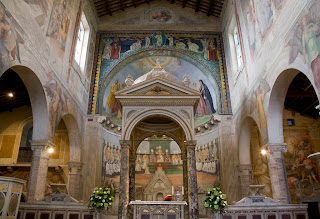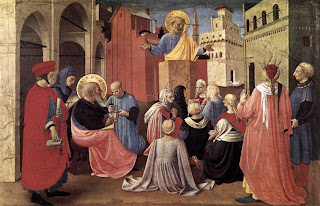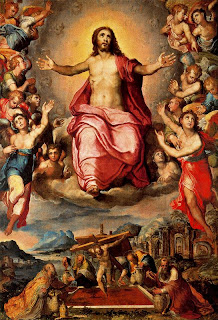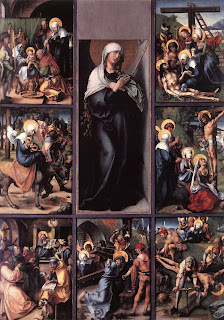As the Church reaches the culmination of the liturgical year in the ceremonies of Holy Week and Easter, the tenor of the lectionary shifts; where the first four weeks of Lent focus on lessons for the catechumens who will be baptized at Easter, Passiontide, and especially Holy Week, closely follows the events of the Lord’s death and Resurrection. As in the earlier part of Lent, and indeed the other seasons when stations are kept, the choice of Roman stational churches in Holy Week is closely tied to the scriptural readings of the Masses. A notable difference is that where the earlier part of Lent took the Pope and his court to every corner of the city’s historical center, the stations of Holy Week are all quite close to the ancient papal residence at the Lateran. The furthest away is Santa Prisca, just a little over a mile distant, with the rest being much closer; the Pope and his court would thus keep their travel to a minimum in a period of lengthy and taxing ceremonies.
On Palm Sunday, the triumphal entry of the Savior into Jerusalem is quite rightly celebrated at the cathedral of Rome dedicated in His name. In the early Middle Ages, a large number of chapels and oratories were constructed by various Popes around the Lateran basilica; one of these was dedicated to Pope St. Sylvester I, and large enough that at least one medieval source refers to it as a basilica. The palms for the procession were blessed there by the cardinal archpriest of St. Lawrence outside-the-Walls, and then brought to the large dining hall known as the triclinium of St. Leo III; there, the Pope distributed them to the clergy and faithful, before the procession made its way through the complex into the cathedral itself. In the later Middle Ages, the Popes often preferred to reside at the Vatican, and so Palm Sunday also has a station informally assigned at St. Peter’s; on these occasions, the palms were blessed in an oratory known as S. Maria in Turri (St. Mary in-the-Tower), directly underneath the bell-tower within the large courtyard that stood before the ancient basilica. During the extensive renovations of the Lateran and Vatican complexes in the 16th and 17th centuries, S. Sylvester in Laterano and S. Maria in Turri were both demolished; and nowadays, the Pope routinely celebrates Palm Sunday at St. Peter’s.
![]() |
| The Basilica of St. Peter as it stood ca. 1450, by H.W. Brewer. |
Ss. Sylvester I and Leo III both sat upon the chair of St. Peter during events of the greatest importance for the history of relations between Church and State. Sylvester was the first Pope to be elected under the peace granted by the Emperor Constantine, and received the property of the Lateran as a gift from him; he was later held to be the recipient of the temporal state of the Church as part of the so-called Donation of Constantine. While this document has long been known to be a fiction, it did not create the Papal State, but rather a legal sanction for the long-standing de facto possession of central Italy by the Papacy after the collapse of the Roman Empire. St. Leo III was the Pope who crowned Charlemagne as the first Holy Roman Emperor, after his predecessor had effectively made the Papal State a protectorate of the Frankish empire. The blessing and distribution of the palms in parts of the Lateran complex associated with these Popes is probably behind the text of the preface which forms part of the blessing of the palms in the Missal of St. Pius V; as many liturgical writers have noted, it is unusual as a preface in that it makes no specific reference to the occasion on which it is used.
Truly it is worthy and just etc. … Who gloriest in the counsel of Thy Saints. For Thy creatures serve Thee, because they know Thee to be their only author and God, and all Thou hast made praiseth Thee, and Thy saints bless Thee. Because with free voice they confess the great name of Thy Only-Begotten Son before the kings and powers of this age. Before Whom stand the Angels and Archangels, Thrones and Dominations, and with all the army of the heavenly host, they sing the hymn of Thy glory, saying without end. Holy, Holy, Holy etc.
On Monday of Holy Week, the station was originally kept at the church known as the “titulus fasciolae – the title of the bandage,” to the south of the Caelian Hill near the Baths of Carcalla. Several explanations have been proposed for this odd name; an ancient tradition states that when St. Peter had been released from prison by his jailers, and was fleeing Rome, he stopped on the site of this church to change the binding on the wound where his fetters had been. The church was also associated with two of the most venerated Roman martyrs of the early centuries, Ss. Nereus and Achilleus; nothing is now known of them for certain beyond their martyrdom and that they were soldiers who renounced their military service to follow Christ. Their unreliable legend states that they were baptized by St. Peter himself, and in the years after the Apostle’s death, made many converts among the Roman nobility, among them, Flavia Domitilla, a relative of the Emperors Vespasian, Titus and Domitian. Being close by the Lateran, their church (now much smaller after extensive restorations in the mid-15th and late 16th centuries) would have made a convenient station after the lengthy ceremony of the previous day.
![]() |
| The interior of Ss. Nereus and Achilleus. Photograph by Fr. Lawrence Lew O.P. |
By the High Middle Ages, it had fallen into ruins, and the station was transferred to the church of St. Praxedes on the Esquiline hill, a few steps away from the basilica of St. Mary Major. Her legend says that during the persecutions, she and her sister Pudentiana expended their patrimony in tending to the saints, providing for their material needs, sheltering them, visiting them in prison, and burying them after they had received the crown of martyrdom. After many years spent in helping the Christians, she prayed God to release her from the sight of such cruelties as were inflicted upon them, and so died a peaceful death. Her feast day is kept on July 21, the day before that of St. Mary Magdalene, who appears in the Gospel of Holy Monday (John 12, 1-9) anointing the feet of Christ. Just as Praxedes and her sister tended to the needs of the martyrs before and after their suffering and death, Mary and her sister Martha tended to Christ before and after His Passion. Today He is received as a guest in their home, and His feet are anointed by Mary Magdalene, who will later come with several other women to His tomb to anoint His body.
![]() |
| Ss. Praxedes and Pudentiana, together with the Virgin Mary, from the mausoleum of Theodora, (portrayed on the left) the mother of Pope St. Paschal I, (817-24). Paschal rebuilt the church and added this funeral chapel on the north side of it; it is also called the Chapel of St. Zeno, but in the Middle Ages was often referred to as the Garden of Paradise. Theodora was still alive when the image was made, hence the square blue halo, as recently noted by David Clayton. |
On Tuesday, the station is kept at the church of St. Prisca on the Aventine Hill. This church is built on the site of a very ancient title and house-church, long believed on good evidence to be one of the places where St. Peter stayed during his years in Rome. The titular saint shares the day of her martyrdom, January 18, with the feast of St. Peter’s Chair in Rome, and the anniversary of the church’s dedication is kept on the feast of St. Peter’s Chair in Antioch. It has been proposed that her association with St. Peter derives from presence of the relic venerated as the Apostle’s chair at the place of her burial, and perhaps later at her church, before it was moved to its present location at the Vatican.
The gospel read at this Mass was originally John 13, 1-32, a longer version of the gospel of the Mass of the Lord’s Supper. In this first chapter of the five which St. John devotes to the events of the Last Supper, St. Peter himself figures very prominently, first as the only disciple to speak when Christ washes the feet of the Twelve, and then as he asks John to ask the Lord which of the disciples is the traitor among them. Later on, it was replaced by the Passion according to St. Mark, the longest of the four Passions in proportion to its Gospel as a whole. St. Jerome, who lived for a time in Rome on the Aventine hill, records the tradition (also attested in much earlier sources) that Mark was the disciple and interpreter of Peter, who calls him “my son” in his first epistle, (5, 13) and composed his gospel in Rome before going to evangelize Egypt. It is therefore possible that St. Prisca stands on the very place where Mark wrote the Gospel, having learned of the life of Christ from one of the most important eyewitnesses.
![]() |
| St. Peter preaching in the presence of St. Mark, by Fra Angelico, ca. 1433, part of the predella of the Linaioli altarpiece. |
The station of Spy Wednesday is held at St. Mary Major, also the station church of the four Ember Wednesdays; as in the Embertides, and the Wednesday of the fourth week of Lent, there are two readings before the gospel. The first of these is Isaiah 63, 1-7, preceded by a part of verse 62, 11.
Thus sayeth the Lord God: Tell the daughter of Sion: Behold thy Savior cometh: behold his reward is with him. Who is this that comes from Edom, with dyed garments from Bosra, this beautiful one in his robe, walking in the greatness of his strength? I, that speak justice, and am a defender to save. Why then is your apparel red, and your garments like theirs that tread in the winepress? I have trodden the winepress alone, and of the gentiles there is not a man with me: I have trampled on them in my indignation, and have trodden them down in my wrath, and their blood is sprinkled upon my garments, and I have stained all my apparel. etc.
The Fathers of the Church understood this passage as a prophecy of the Passion of Christ, starting in the West with Tertullian.
The prophetic Spirit contemplates the Lord as if He were already on His way to His passion, clad in His fleshly nature; and as He was to suffer therein, He represents the bleeding condition of His flesh under the metaphor of garments dyed in red, as if reddened in the treading and crushing process of the wine-press, from which the laborers descend reddened with the wine-juice, like men stained in blood. (adv. Marcionem 4, 40 ad fin.)
This connection of these words with the Lord’s Passion is repeated in very similar terms by St. Cyprian (Ep. ad Caecilium 62), who always referred to Tertullian as “the Master”, despite his lapse into the Montanist heresy; and likewise, by Saints Cyril of Jerusalem (Catechesis 13, 27) and Gregory of Nazianzen (Oration 45, 25.)
The necessary premise of the Passion is, of course, the Incarnation, for Christ could not suffer without a human body. Indeed, ancient heretics who denied the Incarnation often did so in rejection of the idea that God Himself can suffer, which they held to be incompatible with the perfect and incorruptible nature of the divine. St. Ambrose was elected bishop of Milan in the year 374, after the see had been held by one such heretic, the Arian Auxentius, for twenty years. We therefore find him referring this same prophecy to the whole economy of salvation, culminating in the Ascension of Christ’s body into heaven, thus, in the treatise on the Mysteries (7, 36):
The angels, too, were in doubt when Christ arose; the powers of heaven were in doubt when they saw that flesh was ascending into heaven. Then they said: “Who is this King of glory?” And while some said “Lift up your gates, O princes, and be lifted up, you everlasting doors, and the King of glory shall come in.” In Isaiah, too, we find that the powers of heaven doubted and said: “Who is this that comes up from Edom, the redness of His garments is from Bosor, He who is glorious in white apparel?”
In the next generation, St. Eucherius of Lyon (ca. 380-450) is even more explicit: “The garment of the Son of God is sometimes understood to be His flesh, which is assumed by the divinity; of which garment of the flesh Isaiah prophesying says, “Who is this etc.” (Formulas of Spiritual Understanding, chapter 1) Therefore, like the Mass of Ember Wednesday, this Mass begins with a prophecy of the Incarnation as the church of Rome visits its principle sanctuary of the Mother of God, in whose sacred womb began the salvation of man.
![]() |
| The Risen Christ and the Mystical Winepress, by Marco dal Pino, often
called Marco da Siena, 1525-1588 ca. Both of the figures of Christ in
this painting show very markedly the influence of Michelangelo's Last Judgment. |
This is also the day on which the church reads the Passion according to St Luke, who has a special association with the Virgin Mary. Most of what the New Testament tell us about Her was recorded in his writings, including almost all of the words actually spoken by the Her; this fact lies behind the tradition that St. Luke painted a picture of the Virgin, which is figuratively true even if it were not literally so. It is his account of the Passion that tells of the meeting between Christ and a group of women on the way to Mount Calvary, (chapter 23, 27-30); although he does not say that Mary was among them, art and piety have long accepted that it was so. The special devotion of the Servite Order to the Seven Sorrows of the Virgin has both a proper rosary (as the Franciscans have a rosary of the Seven Joys) and a special form of the Via Crucis, called by them the Via Matris; in both, the fourth sorrow is the encounter between Christ and His Mother as He bears the Cross.
![]() |
| The Seven Sorrows of the Virgin Mary, by Albrecht Durer, ca. 1496. The lower middle panel show the Virgin fainting as Her Son passes by Her on the street on the way to Mount Calvary. |
For the ceremonies of Holy Thursday, the station was of course kept at the cathedral of Rome. On this day, in addition to celebrating the Mass of the Lord’s Supper, the Pope would preside over the reconciliation of the public penitents, and bless the holy oils, both rituals proper to the office of a bishop. Likewise, the washing of the feet (known as the
Mandatum from the first antiphon sung during the rite) is done on this day, a ritual not exclusive to bishops, but traditionally performed by religious superiors upon their subjects, as Christ Himself did. The gospel sung at both the Mass and the Mandatum is taken from St. John (chapter 13, 1-15), since the three Synoptic accounts of the Lord’s Supper have been read earlier in the week. In a later period, the church came to be dedicated also to him and to St. John the Baptist; and it is he whose account of the Passion will also be read on the following day, on which the Church refrains from the celebration of Mass in mourning for the death of the Savior. (This year, the Pope will celebrate the Chrism Mass at St. Peter's, and the Mass of the Lord's Supper at St. John in the Lateran.)
Finally, the station of Good Friday is kept at the basilica of the Holy Cross ‘in Jerusalem’. This denomination comes from the tradition that when St. Helena, Constantine’s mother, built the church to house the relics of the True Cross discovered by herself in the Holy Land, the ground first was covered with earth brought from the city of the Lord’s Passion. As the Bl. Ildefonse Schuster writes in his book on the liturgical traditions of Rome,
The Sacramentary, the choice of station fulfills the words of Christ Himself, “it cannot be that a prophet perish out of Jerusalem.”
![]() |
| A reliquary with pieces of the True Cross from the relic chapel of Holy Cross in Jerusalem. |
Holy Saturday will be included in an article to be published next week on the stations of the Easter Octave.![]()















































































